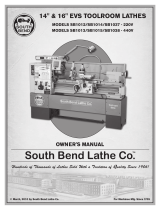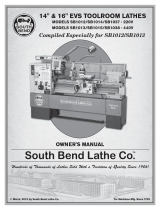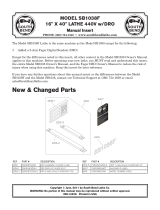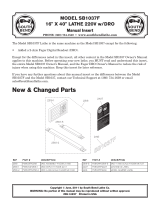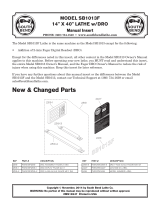Page is loading ...

INSTRUCTION MANUAL
MODEL: KC-1440ML
COPYRIGHT © 2003 ALL RIGHTS RESERVED BY KING CANADA TOOLS INC.
14” X 40”
GEARHEAD METAL LATHE

IMPORTANT INFORMATION
2
2
-
-
Y
Y
E
E
A
A
R
R
LIMITED WARRANTY
FOR THIS 14” X 40” METAL LATHE
K
K
I
I
N
N
G
G
C
C
A
A
N
N
A
A
D
D
A
A
T
T
O
O
O
O
L
L
S
S
OFFERS A 2-YEAR LIMITED WARRANTY
FOR INDUSTRIAL USE.
PROOF OF PURCHASE
Please keep your dated proof of purchase for warranty and servicing purposes.
REPLACEMENT PARTS
Replacement parts for this tool are available at our authorized KING CANADA service centers across Canada. For servicing, contact
or return to the retailer where you purchased your product along with your proof of purchase.
LIMITED TOOL WARRANTY
KING CANADA makes every effort to ensure that this product meets high quality and durability standards. KING CANADA warrants to
the original retail consumer a 2-year limited warranty as of the date the product was purchased at retail and that each product is free
from defects in materials. Warranty does not apply to defects due directly or indirectly to misuse, abuse, negligence or accidents,
repairs or alterations and lack of maintenance. KING CANADA shall in no event be liable for death, injuries to persons or property or
for incidental, special or consequential damages arising from the use of our products. To take advantage of this warranty, the product
or part must be returned for examination by the retailer. Shipping and handling charges may apply. If a defect is found, KING CANADA
will either repair or replace the product.
PARTS DIAGRAM & PARTS LISTS
Refer to the Parts section of the King Canada web site for the most updated parts diagram and parts list.
K
K
I
I
N
N
G
G
C
C
A
A
N
N
A
A
D
D
A
A
T
T
O
O
O
O
L
L
S
S
I
I
N
N
C
C
.
.
D
D
O
O
R
R
V
V
A
A
L
L
,
,
M
M
O
O
N
N
T
T
R
R
E
E
A
A
L
L
,
,
Q
Q
U
U
E
E
B
B
E
E
C
C
,
,
C
C
A
A
N
N
A
A
D
D
A
A
H
H
9
9
P
P
2
2
Y
Y
4
4

GENERAL SAFETY INSTRUCTIONS
FOR POWER TOOLS
1
. KNOW YOUR TOOL
Read and understand the owners manual and labels affixed to
the tool. Learn its application and limitations as well as its
specific potential hazards.
2. GROUND THE TOOL.
This tool is equipped with an approved 3-conductor cord and
a 3-prong grounding type plug to fit the proper grounding type
receptacle. The green conductor in the cord is the grounding
wire.
NEVER connect the green wire to a live terminal.
3. KEEP GUARDS IN PLACE.
Keep in good working order, properly adjusted and aligned.
4. REMOVE ADJUSTING KEYS AND WRENCHES.
Form habit of checking to see that keys and adjusting
wrenches are removed from tool before turning it on.
5. KEEP WORK AREA CLEAN.
Cluttered areas and benches invite accidents. Make sure the
floor is clean and not slippery due to wax and sawdust
build-up.
6. AVOID DANGEROUS ENVIRONMENT.
Don’t use power tools in damp or wet locations or expose
them to rain. Keep work area well lit and provide adequate
surrounding work space.
7. KEEP CHILDREN AWAY.
All visitors should be kept a safe distance from work area.
8. MAKE WORKSHOP CHILD-PROOF.
Use padlocks, master switches or remove starter keys.
9. USE PROPER SPEED.
A tool will do a better and safer job when operated at the
proper speed.
10. USE RIGHT TOOL.
Don’t force the tool or the attachment to do a job for which it
was not designed.
11. WEAR PROPER APPAREL.
Do not wear loose clothing, gloves, neckties or jewelry (rings,
watch) because they could get caught in moving parts. Non-
slip footwear is recommended. W
ear protective hair covering
to contain long hair. Roll up long sleeves above the elbows.
1
2. ALWAYS WEAR SAFETY GLASSES.
Always wear safety glasses (ANSI Z87.1). Everyday
eyeglasses only have impact resistant lenses, they are
NOT
safety glasses. Also use a face or dust mask if cutting
o
peration is dusty.
13. DON’T OVERREACH.
Keep proper footing and balance at all times.
14. MAINTAIN TOOL WITH CARE.
Keep tools sharp and clean for best and safest performance.
Follow instructions for lubricating and changing accessories.
15. DISCONNECT TOOLS.
Before servicing, when changing accessories or attachments.
16. AVOID ACCIDENTAL STARTING.
Make sure the swich is in the ‘’OFF’’ position before plugging
in.
17. USE RECOMMENDED ACCESSORIES.
Consult the manual for recommended accessories. Follow the
instructions that accompany the accessories. The use of
improper accessories may cause hazards.
18. NEVER STAND ON TOOL.
Serious injury could occur if the tool tips over. Do not store
materials such that it is necessary to stand on the tool to reach
them.
19. CHECK DAMAGED PARTS.
Before further use of the tool, a guard or other parts that are
damaged should be carefully checked to ensure that they will
operate properly and perform their intended function. Check for
alignment of moving parts, breakage of parts, mounting, and
any other conditions that may affect its operation. A guard or
other parts that are damaged should be properly repaired or
replaced.
20. NEVER LEAVE MACHINE RUNNING
UNATTENDED.
T
urn power ‘’OFF’’. Don’t leave any tool running until it comes
to a complete stop.

ELECTRICAL & TECHNICAL
INFORMATION
ELECTRICAL INFORMATION
WARNING!
A
LL ELECTRICAL CONNECTIONS MUST BE DONE BY A QUALIFIED ELECTRICIAN
.
FAILURE TO COMPLY MAY RESULT IN SERIOUS
INJURY! ALL ADJUSTMENTS OR REPAIRS MUST BE DONE WITH THE METAL LATHE DISCONNECTED FROM THE POWER SOURCE.
FAILURE TO COMPLY MAY RESULT IN SERIOUS INJURY!
POWER SUPPLY
WARNING:
THIS METAL LATHE MUST BE ‘HARDWIRED’ (connected directly to the circuit breaker without the use of a plug). We recommend
that only a qualified electrician do the initial ‘Hardwiring’ of this metal lathe.
WARNING:
YOUR METAL LATHE MUST BE CONNECTED TO A 240V, 15-AMP (MINIMUM) BRANCH CIRCUIT WITH A 15-AMP TIME DELAY FUSE
OR CIRCUIT BREAKER. FAILURE TO CONNECT IN THIS WAY CAN RESULT IN INJURY FROM SHOCK OR FIRE.
THIS METAL LATHE MUST BE GROUNDED
. IF NOT PROPERLY GROUNDED, THIS METAL LATHE CAN CAUSE ELECTRICAL SHOCK,
PARTICULARLY WHEN USED IN DAMP LOCATIONS. TO AVOID SHOCK OR FIRE, IF THE POWER CORD IS WORN OR DAMAGED IN
ANY WAY, HAVE IT REPLACED IMMEDIATELY.
TECHNICAL INFORMATION KC-1440ML
Main Specifications
Max. swing over bed ......................................................................................................................................................................14” (355mm)
Max. swing over saddle gap ....................................................................................................................................................20-1/4” (514mm)
Max. swing over cross slide ......................................................................................................................................................8-5/8” (219mm)
Distance between centers ............................................................................................................................................................40” (1016mm)
Headstock
Spindle bore diameter ................................................................................................................................................................1-7/16” (37mm)
Spindle bore taper ....................................................................................................................................................................................MT#5
Spindle speed range ............................................................................................................................................................8 (70-2000 R.P.M.)
Gear Box
Thread cutting: ......................................................................................................................................................................Inches (4-56 T.P.I.)
...................................................................................................................................................................................... Metric (0.4 - 7mm)
Tool Post, Saddle, Tailstock
Top Slide travel ............................................................................................................................................................................3-1/2” (88mm)
Cross Slide travel ....................................................................................................................................................................6-3/16” (157mm)
Tailstock taper ............................................................................................................................................................................................MT#3
Tailstock quill travel ..........................................................................................................................................................................4” (100mm)
Diameter of Tailstock quill ............................................................................................................................................................1-1/4” (32mm)
Motor
Horsepower
................................................................................................................................................................................................
2 HP
V
oltage
........................................................................................................................................................................................
240V
, 1 phase
Amperage
..............................................................................................................................................................................................
1
1 amp.
Motor R.P.M.....................................................................................................................................................................................1720 R.P.M.
Motor frequency..........................................................................................................................................................................................
60Hz

Before operating this metal lathe, read this instruction manual and
familiarize yourself with the required adjustments, operation
procedures, maintenance and lubrication.
CLEANING & PREPARING LATHE BEFORE THE FIRST TEST
RUN
After unpacking, remove the paper (or grease found on unpainted
ground surfaces) from the machine and using a non-volatile solvent
and a brush, remove grease.
During transport and unpacking, it is likely that debris will be present
on top of the lathe. Do not move the carriage and the tailstock until
the rest of the metal lathe (mainly the bed) has been thoroughly
cleaned.
Remove all accessories and machine parts from the tool box and
install all the handles and knobs. Fix the follow rest to the carriage
using 2 cap screws and fix the steady rest inbetween the chuck and
the carriage.
Make sure that all lubrication points and oil levels have been
inspected before putting your metal lathe into operation. See
“Lubrication Points” section further in this manual before operating
your lathe.
This machine is equipped with 2 V-belts from the motor to the lower
rear pulley. It is advisable to check the belt tension before starting the
metal lathe. There should be no more than a 1/2” center deflection
with light finger pressure. Adjust the V-belt tension as necessary.
V-belts which are tensionned too tightly will damage the bearing.
Before performing test runs, set the changing lever on the lowest
speed and let the machine operate for 20 minutes. If everything is
functionning normally, increase the spindle speed step by step until
the highest speed, each step operating for 5 minutes.
FIGURE 1
CLEANING, TEST RUN,
GETTING TO KNOW YOUR LATHE
1- Headstock
2- Chuck safety guard
3- Steady rest
4- Tool post
5- Follow rest (not fully shown)
6- Halogen Lamp
7- Collant system
8- Top slide
9- Cross slide
10- Bedway
11- Tailstock
12- Control switches
13- Gear box
14- Chuck
15- Foot brake
16- Carriage
17- Start
18- Feed shaft
19- Leadscrew
20- Gear rack
1
2
3
4
5
6
7
8
9
20
19
18
14
13
12
11
10
Getting to know your Metal Lathe
Optional Accessories available:
• KLC-3M -Live Center (MT#3)
• KM-054 -Taper Attachment
• KM-057 -7pc. Deluxe Cutter Holder Set
15
16
17

OPERATING LEVERS
Metal Lathe Operating Levers (Fig.2)
Headstock Levers
•Lever 1 is the H/L speed selector, this lever allows you to set the
s
peed to H (high) or L (low).
•Lever 2 is the 4-step speed selector which allows you to set the
s
pindle speed.
•Lever 3 is the spindle direction selector. Do not change this setting
while the machine is running.
Quick Change Gear Box Knobs
•Selector knobs 4, 5, 6 & 7 set the gear box feed rate. Turning these
knobs can provide many feed rates and inch thread pitches as
indicated in the charts in the metal lathe plates. With the use of
metric change gears, these levers can also provide metric threads
using the “MM Gear Change” chart which is also found in the metal
lathe plates.
Caution: Always stop the spindle before engaging any of the
above knobs (knobs 4-7).
Carriage Assembly Levers
• Handwheel 8 is used to manually move the carriage along the
bedway of the lathe.
• The crossfeed handwheel 10 is used to manually move the cross
slide in or out.
• The feed lever 11 is used to engage either the longitudinal or cross
feed. This lever has a safety interlock to prevent accidental
engagement of the half nuts when the lathe is in feed mode. There
are 3 positions; the upper position engages the power longitudinal
feed, the lower position engages the power cross feed and the
center position is the disengaged position.
• The thread lever 12 is used to engage the half nuts when threading.
• The top slide handwheel 17 is used to manually move the tool post.
T
he top slide is fully adjustable to any angle and is also used for
threading or machining an angle on a workpiece.
•
The thread cutting dial 16 is used to engage the half nuts with the
leadscrew in the same thread that has been previously cut. Please
note: Use any line of the dial for even pitches of threads, but for odd
pitches of threads you must use the same starting line. Example:
When cutting a shaft with 10 T.P.I., engage the half nuts at any
number on the thread dial, when creating an odd pitch, if you start
the cut using 1 or a 3, continue to use the 1 or the 3 until the thread
is finished.
• The clamp lever 18 is used to secure the tool post block.
Tailstock levers
• The handwheel 13 is used to feed or retreat the tailstock quill. Tip:
Turning the handwheel completely couterclockwise until a full stop
will automatically eject the tourning tool used.
• The tailstock clamp lever 14 locks the tailstock to the bedway. To
lock, pull the lever upwards, to release lower the lever.
Stand
• Foot brake 9 stops the spindle. This allows you to stop the spindle
quickly and then change the rotation if needed.
9
17
15
13
3
1
4
5
FIGURE 2
14
6
7
8
10
1
1
12
16
2
18

METAL LATHE CHARTS
Metal Lathe Charts
Below are all the charts which are found on the metal
lathe plates. We have included these charts in this
manual for reference purposes, in case one or many
plates have been damaged and are no longer readable.
FIGURE 6- 8 Step Spindle Speed Chart
FIGURE 3- Inch Thread Pitch Chart
FIGURE 5B- Feed Rate/Thread Selection Chart
FIGURE4- Metric Thread Pitch Chart
FIGURE 7- Thread Dial Indicator Chart
FIGURE 5A- Imperial Feed Rate Chart

ADJUSTMENTS & OPERATION
Mounting or removing chuck or face plate
B
efore mounting a chuck, face plate or other attachments (A) Fig.8, it is
very important that the mounting surfaces on both the spindle nose (B) and
the attachment are extremely clean.
All the camlocks (C) should be in their release position (camlock mark line
m
atches the spindle nose mark line) and the cap screws (D) must be loos-
ened before mounting. Mount the attachment onto the spindle nose, once
the attachement is in position, each camlock must be tightened and locked
into place. Camlocks are tightened by turning them clockwise using the
provided Camlock Key. The cams are properly locked into place when the
camlock mark line is inbetween the 2 V’s on the spindle nose, see Fig.8.
Retighten cap screws (D) into spindle nose and tighten using appropriate
hex. key.
Adjusting and reversing chuck jaws
Chuck jaws (A) Fig.9 can be opened or closed by using the camlock key
in the jaw adjustment cams (B). Turning the camlock key (C) clockwise will
closed the jaw opening and counterclockwise will open the jaw opening.
Before reversing the direction of the chuck jaws, two major points must be
followed every time.
1) The chuck jaws are numbered (ex.: 3 jaw chuck- 1,2,3) and must be
placed in numerical order into the chuck.
2) If the chuck jaws are to be removed, you must replace them in the
identical slot which they were taken out of. (Make sure they are also in
numerical order).
To remove chuck jaws, open jaw opening all the way using camlock key
until the jaws practically fall out. Do not let the jaws fall, hold them while
you open the jaw opening. Change the direction of each jaw and apply
pressure on them towards the center of the chuck. Turn camlock key
clockwise and make sure all jaws engage the spiral mechanism.
Installing and operating follow rest and steady rest
The follow and steady rests serve as workpiece supports during
operations. Install the follow rest (A) Fig.10 to the saddle (B) using 2 cap
screws. Install the steady rest (C) to the bedway (D) (inbetween the
carriage and the chuck) using the clamp shoe, bolt and lock nut assembly.
The follow rest is installed near the cutting tool to give additional support.
If the follow rest would not be used, the cutting tool pressure on the
workpiece could warp your workpiece and give undesired results.
Position workpiece in the steady rest and the follow rest. Secure
workpiece in rests by tightening the centers but do not overtighten.
FIGURE 8
FIGURE 9
FIGURE 10

ADJUSTMENTS & OPERATION
T
ailstock Adjustments & Operation
The tailstock can be moved freely on the bedway and fastened at any
position by locking tailstock lever (A) Fig.11. The tailstock quill can be
m
oved in and out by using handwheel (B) and then fastened in place using
quill locking lever (C). Dead centers or drill chucks are normally installed
in the tailstock quill.
An important adjustment and verification must be done in order to obtain
the best results using your tailstock. The tailstock must be perfectly
aligned with the chuck. Fix a ground steel bar inbetween the chuck center
and the tailstock center. Using a precise measuring tool, make sure the
distance at both ends of the ground steel bar are the same using the top
slide as starting reference point, see Fig.12. If the distance is not the
same, then an cross wise adjustment to the tailstock is necessary.
Unlock tailstock lever (A) Fig.11 and adjust set screws (D) on both sides
of the tailstock until the distance at both ends of the ground steel bar are
the same.
Tool Post Adjustments & Operation
The tool post assembly (A) Fig.13 is used to lock the cutting tool into place
at the desired height and angle. The tool post can pivot 360
0
for various
cutting situations. To pivot the tool post assembly, loosen lock nut (B) and
pivot tool post, retighten lock nut. The tool post comes with a tool holder
(C) which can be adjusted to a desired height using the shaft and nuts
mechanism (D) to raise or lower the tool holder. Once the height of the tool
holder is determined, use tool post lock handle (E) to lock tool holder in
place. The tool holder has 4 locking set screws (F) which lock the cutting
tool in place.
Cross & Top Slide Adjustments & Operation
The cross slide handwheel (A) Fig.14 is used to feed the cross slide, top
slide and tool post with cutting tool towards the workpiece. After time the
cross slide gib (B) may become loose or too tight and an adjustment may
be necessary.
T
o adjust the gib (B), tighten or loosen the flat head bolt (C)
until the cross slide moves freely without play
.
The top slide handwheel (D) feeds the top slide and tool post with cutting
tool towards the chuck or the tailstock end of the lathe. After time the top
slide gib may become loose or too tight and an adjustment may be
necessary.
The top slide can be pivoted to a desired angle, to adjust the angle of the
top slide simply loosen cap screws (E) on both sides of the top slide base.
FIGURE 11
FIGURE 12
FIGURE 13
FIGURE 14

ADJUSTMENTS & OPERATION
F
eed and Thread Selection
To set the desired feed rate and thread selection, it may be necessary to
change the gear configuration, refer to charts in Fig’s.3, 4, 5A & 5B. 36
f
eed speeds are possible in either the longitudinal or cross direction Fig.
5A. Once you have determined the job at hand (feed speed and thread),
p
lace the selector knobs (A -D) Fig.15 in the appropriate positions.
If you desire Metric Threads, mm change gears must be installed as
indicated in chart Fig.4 and as described below.
Change gears
T
o obtain metric threads the proper change gears must be installed inside
the left side cover. Remove the 2 lock nuts which hold the left side cover
to the headstock and then remove the side cover.
Before changing gears, determine the threads per mm desired and look at
which gear configuration is needed, see chart Fig.4 as reference. The
large middle gear (A) Fig.16 is the only gear which does not get
interchanged. To replace the top gear (B), remove nut (C) which holds it in
place. Replace with appropriate gear and secure with nut. To replace the
bottom gear (D), remove gear cap screw (E). Once the change gears are
in place, reposition the side cover and lock it using the same lock nuts
removed previously.
Automatic Power Feed- Longitudinal or Cross Feed
The power feed lever (A) Fig.17 is used to engage either the longitudinal
or cross feed. This lever has a safety interlock to prevent accidental
engagement of the half nuts when the lathe is in feed mode. There are 3
positions; the upper position engages the power longitudinal feed, the
lower position engages the power cross feed and the center position is the
disengaged position.
Make sure the correct gear configuration is set as shown in charts Fig.3,
4, 5A & 5B. Place the feed/thread selector to ANY position and make sure
the thread cutting engagement lever (B) is disengaged before operating.
Thread Cutting Operation
In order to obtain the desired thread, all change gears must be installed in
accordance to the thread charts. Failure to do so will give incorrect
threads.
Move the thread cutting engagement lever (B) Fig.17 downwards, this will
make it engage with the leadscrew for longitudinal travel of the carriage.
Make sure the power feed lever (A) is disengaged (in neutral position)
before operating the thread cutting engagement lever (B), note: a safety
interlock prevents accidental engagement of the half nuts when the lathe
is in feed mode.
FIGURE 15
FIGURE 16
FIGURE 17
Thread Cutting Dial Operation
The thread cutting dial is used to engage the half nuts with the
leadscrew in the same thread that has been previously cut.
Please note: Use any line of the dial for even pitches of threads,
but for odd pitches of threads you must use the same starting
line.
Example: When cutting a shaft with 10
T
.P.I., engage the half
nuts at any number on the thread dial, when creating an odd
pitch, if you start the cut using 1 or a 3, continue to use the 1 or
the 3 until the thread is finished. See Fig.7.

COOLANT SYSTEM &
LUBRICATION POINTS
Using the Coolant System
It is suggested to use the coolant system during operations involving
high speed cutting. Excessive heat and damage to your cutting tool will
b
e avoided if the coolant system is on with the spout directed towards
the cutting tool and the work area during the cutting operation.
The coolant system operates by recycling the coolant flow from the
coolant pump up through the coolant spout, then falls into the chip tray
and drains back down to the coolant pump and the cycle is repeated.
To fill the system with coolant, simply pour coolant into the chip tray, it
will flow down into the coolant bucket. Be careful not to overflow.
The amount of flow is controled by a valve at the base of the coolant
spout. For maximum flow, open the valve completely.
Lubrication Points
Before operating the metal lathe,
check the oil level and lubricate all
sliding surfaces such as the dovetail slot, half nut, worm gear,
l
eadscrew, feed rod, handle rod, tailstock quill before and after
operating. Follow the main lubrication points illustrated below.
Note: Headstock lubrication point (1). After running for the first 3
months, change the oil. Change oil once a year after first initial oil
change. To drain oil from the headstock, remove left end cover and the
gear change swing arm to gain access to the drain hole, drain oil and
then open top oil cover and fill oil until it reaches the 3/4 mark on the
oil level indicator. The bearings should be completely immersed in oil.
•Carriage lubrication point (5). The carriage is filled with machine oil
through the filling plug on the top of the carriage. Oil level should be
checked regularly. Change oil after the first 3 months and once every
year after.
•Gear Change lubrication point (3). Lubricate the change gears with
thick machine oil or grease once a month.
•A light oil should be used on the bedway and all other reflective parts
such as the tailstock quill.
Lubrication Points
Headstock lubrication point (1)
.
Gear Box lubrication point (2).
Gear Change lubrication point (3).
Saddle lubrication point (4).
Carriage lubrication point (5).
Handwheel lubrication point (6).
Leadscrews & Bracket lubrication points (7).
Tailstock lubrication points (8).
Tool Post Slide lubrication point (9).
Top slide set screw lubrication point (10).
5
4
8
7
6
1
3
2
FIGURE 18
9
10
/
